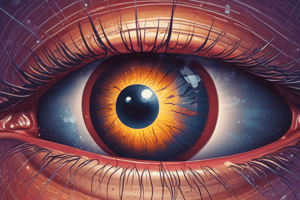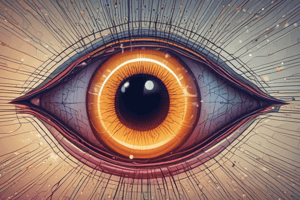Podcast
Questions and Answers
What causes the pupil to constrict when exposed to light?
What causes the pupil to constrict when exposed to light?
- Action of the dilator muscle
- Increased pressure in the eye
- Activation of the optic nerve
- Pupillary light reflex (correct)
Where does the afferent limb of the light reflex originate?
Where does the afferent limb of the light reflex originate?
- Retinal ganglion cells (correct)
- Ciliary ganglion
- Superior colliculus
- Edinger-Westphal nuclei
Which nerve joins the long ciliary nerves to reach the dilator muscle?
Which nerve joins the long ciliary nerves to reach the dilator muscle?
- Facial nerve
- Trigeminal nerve (correct)
- Vagus nerve
- Abducens nerve
In the light reflex pathway, signals are relayed bilaterally from which structure?
In the light reflex pathway, signals are relayed bilaterally from which structure?
What phenomenon describes the nonrhythmical, small-amplitude fluctuations of the pupil?
What phenomenon describes the nonrhythmical, small-amplitude fluctuations of the pupil?
Which structure is located just rostral to the superior colliculus?
Which structure is located just rostral to the superior colliculus?
What is the role of the Edinger-Westphal nuclei in the light reflex?
What is the role of the Edinger-Westphal nuclei in the light reflex?
Which artery continues its ascent through the skull alongside the relevant nervous structures?
Which artery continues its ascent through the skull alongside the relevant nervous structures?
What is the primary pathway for light signals from the eye to the brain?
What is the primary pathway for light signals from the eye to the brain?
What determines the size of the pupil?
What determines the size of the pupil?
Which muscle constricts the pupil?
Which muscle constricts the pupil?
Under which type of neural control does the sphincter pupillae function?
Under which type of neural control does the sphincter pupillae function?
Where do second-order neurons exit to join the sympathetic chain?
Where do second-order neurons exit to join the sympathetic chain?
From where do third-order neurons arise after synapsing with second-order neurons?
From where do third-order neurons arise after synapsing with second-order neurons?
The dilator pupillae is primarily under which type of control?
The dilator pupillae is primarily under which type of control?
What separates sudomotor fibers related to facial sweating from those serving pupil dilation?
What separates sudomotor fibers related to facial sweating from those serving pupil dilation?
Which anatomical location do second-order neurons ascend to after exiting the ventral horns?
Which anatomical location do second-order neurons ascend to after exiting the ventral horns?
Which of the following accurately describes the function of the sphincter pupillae?
Which of the following accurately describes the function of the sphincter pupillae?
Flashcards are hidden until you start studying
Study Notes
Pupillary and Eyelid Abnormalities
- Pupil size is regulated by two iris muscles: sphincter pupillae (parasympathetic control) and dilator pupillae (sympathetic control).
- Sphincter muscles circumferentially constrict the pupil, while dilator muscles are arranged radially to dilate the pupil.
- The pupillary light reflex involves constriction of the pupil upon exposure to light, with the afferent limb originating from retinal ganglion cells.
- Signals travel via the optic nerve, chiasm, and optic tract to the dorsal midbrain pretectum before relaying to the Edinger-Westphal nuclei.
- Afferent pathway for pupillary light reflex involves bilateral neuronal signaling to control bilateral pupil responses.
Neural Pathways
- Second-order neurons exit to the paravertebral sympathetic chain, passing the lung apex and ascending with the common and internal carotid arteries.
- After synapsing at the superior cervical ganglion, third-order neurons carry signals for dilator muscle activation.
- These neurons ascend with the internal carotid artery to the skull base, joining the abducens nerve and trigeminal nerve for transmission to pupil dilator muscles via long ciliary nerves.
Normal Pupil Phenomena
- Hippus, or pupillary unrest, refers to nonrhythmical, small-amplitude fluctuations in pupil size.
Studying That Suits You
Use AI to generate personalized quizzes and flashcards to suit your learning preferences.




